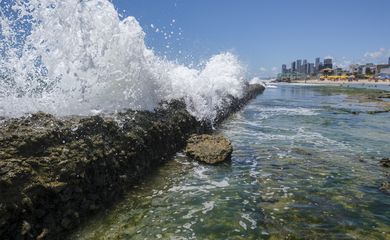Coral bleaching spreading in Northeast Brazil

Coral bleaching in Northeast Brazil is on the rise. Recent monitoring in the Tamandaré region in Pernambuco state, situated in the northern sector of the Costa dos Corais Environmental Protection Area (APA), reveals that the most sensitive species, the fire corals (Millepora sp.), are already experiencing "quite extensive" bleaching, according to Beatrice Padovani, a researcher at the Federal University of Pernambuco (UFPE).

“We observe that the most resistant species are starting to turn pale, but they are not completely bleached. A few species still survive,” says Padovani, who coordinates the Sustainable Tamandaré Long-Term Ecological Program (Pels-Tams), responsible for monitoring this stretch of coastline.
Last week, Agência Brasil reported the onset of a new global bleaching event affecting Brazilian reefs, including areas such as Tamandaré and Porto de Galinhas in Pernambuco, and the coast of Sergipe state.
Corals are marine invertebrate animals capable of feeding individually, but a significant portion of their nutrition comes from a symbiotic relationship with zooxanthellae algae. Through photosynthesis, these single-celled organisms provide nutrients to their animal hosts in a mutually beneficial partnership.
Zooxanthellae also contribute to the vibrant colors of corals. However, when sea temperatures increase, these algae leave the coral, causing them to turn white. Without the nutrients provided by the algae, corals can survive for several months by feeding on microorganisms. Nevertheless, their health is compromised, rendering them more susceptible to disease and death.
"Bleaching is a natural phenomenon that can occur for various reasons, but extensive bleaching often happens due to a thermal anomaly, when temperatures rise above the climatological average," explains the researcher. "We monitor the event and assess the percentage of the population affected. If it exceeds 50 percent, for instance, it is already considered mass bleaching."
Alert
The alert for global mass bleaching came from the North American Meteorology and Oceanography Agency (NOAA), responsible for monitoring ocean temperatures. Their latest statement, published last week, indicates a 90 percent probability of bleaching occurring in various regions worldwide, between March and July of this year.
"Lately, we've witnessed increasingly frequent bleaching events. If we look at the past decade, significant events occurred in 2016, 2019, and 2020. Now, in 2024, we're facing another event that appears to be quite substantial. Not only are these events occurring more frequently, but they're also more intense and persistent. This serves as a warning from coral reefs regarding the global climate issue that affects the entire world," emphasizes the researcher. "Coral reefs can provide crucial warnings about climate change. It won't just be coral reefs that will be affected; it's a wake-up call for humanity as a whole."
In addition to combating climate change, which contributes to rising ocean temperatures, other measures are crucial for improving the health of coral reefs. These include preventing the discharge of sewage into the sea, reducing plastic usage, which often ends up in the oceans, and preserving associated ecosystems like mangroves and sandbanks.



